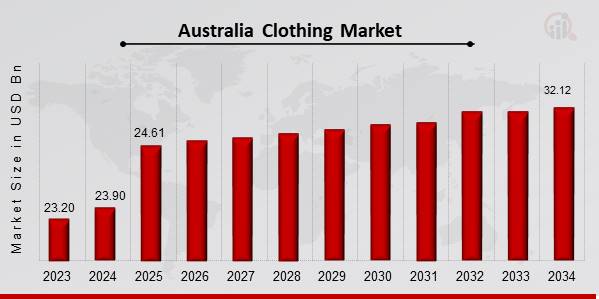How Will Economic Pressures Shape the Future of Fashion in Australia?

Gill Leonard
2025-07-04 18:18
5
0
-
- 첨부파일 : Australia Clothing Market.jpg (25.1K) - 다운로드
본문
Market Overview
In 2024, Australia's Clothing Market was estimated to be worth USD 23.90 billion. The apparel business is expected to increase at a compound annual growth rate (CAGR) of 3% between 2025 and 2034, from USD 24.61 billion in 2025 to USD 32.12 billion by 2034. The primary market factors expected to propel Australia's clothing market include growing online shopping demand, evolving consumer preferences for branded products, and growing awareness of the value of sports and fitness.
Key segments in the market include men's, women's, and children's apparel, with women's wear dominating the industry. The rise in e-commerce has also revolutionized how Australians shop, with online retailing becoming a significant driver of growth.
Key Trends Driving the Market
1. Sustainability and Ethical Fashion
Australian consumers are increasingly leaning towards sustainable and eco-friendly clothing options. Brands like Spell & The Gypsy Collective and Outland Denim are leading the charge by offering ethically sourced and produced apparel. With environmental concerns becoming a top priority, sustainable fashion is no longer a niche but a mainstream demand.
2. Athleisure Boom
The line between casual and activewear continues to blur, with athleisure becoming a wardrobe staple. Local and international brands like Lorna Jane and Nike have capitalized on this trend, offering stylish yet functional apparel. The work-from-home culture has further accelerated this shift, making comfort a top priority for consumers.
3. Digital Transformation and E-commerce
The rise of digital platforms has revolutionized the Australian clothing market. Online marketplaces such as The Iconic and ASOS have made shopping more accessible, while social media platforms like Instagram and TikTok serve as powerful tools for fashion inspiration and marketing. The integration of AI in e-commerce, including virtual try-ons and personalized recommendations, is reshaping consumer experiences.
4. Rise of Local Designers
Australian fashion brands and designers are gaining international recognition. Labels like Zimmermann, Aje, Camilla and Marc are celebrated for their unique designs that blend contemporary and timeless styles. This local love has boosted the domestic clothing market as Australians are increasingly supporting homegrown talent.
In 2024, Australia's Clothing Market was estimated to be worth USD 23.90 billion. The apparel business is expected to increase at a compound annual growth rate (CAGR) of 3% between 2025 and 2034, from USD 24.61 billion in 2025 to USD 32.12 billion by 2034. The primary market factors expected to propel Australia's clothing market include growing online shopping demand, evolving consumer preferences for branded products, and growing awareness of the value of sports and fitness.
Key segments in the market include men's, women's, and children's apparel, with women's wear dominating the industry. The rise in e-commerce has also revolutionized how Australians shop, with online retailing becoming a significant driver of growth.
Key Trends Driving the Market
1. Sustainability and Ethical Fashion
Australian consumers are increasingly leaning towards sustainable and eco-friendly clothing options. Brands like Spell & The Gypsy Collective and Outland Denim are leading the charge by offering ethically sourced and produced apparel. With environmental concerns becoming a top priority, sustainable fashion is no longer a niche but a mainstream demand.
2. Athleisure Boom
The line between casual and activewear continues to blur, with athleisure becoming a wardrobe staple. Local and international brands like Lorna Jane and Nike have capitalized on this trend, offering stylish yet functional apparel. The work-from-home culture has further accelerated this shift, making comfort a top priority for consumers.
3. Digital Transformation and E-commerce
The rise of digital platforms has revolutionized the Australian clothing market. Online marketplaces such as The Iconic and ASOS have made shopping more accessible, while social media platforms like Instagram and TikTok serve as powerful tools for fashion inspiration and marketing. The integration of AI in e-commerce, including virtual try-ons and personalized recommendations, is reshaping consumer experiences.
4. Rise of Local Designers
Australian fashion brands and designers are gaining international recognition. Labels like Zimmermann, Aje, Camilla and Marc are celebrated for their unique designs that blend contemporary and timeless styles. This local love has boosted the domestic clothing market as Australians are increasingly supporting homegrown talent.


댓글목록0
댓글 포인트 안내